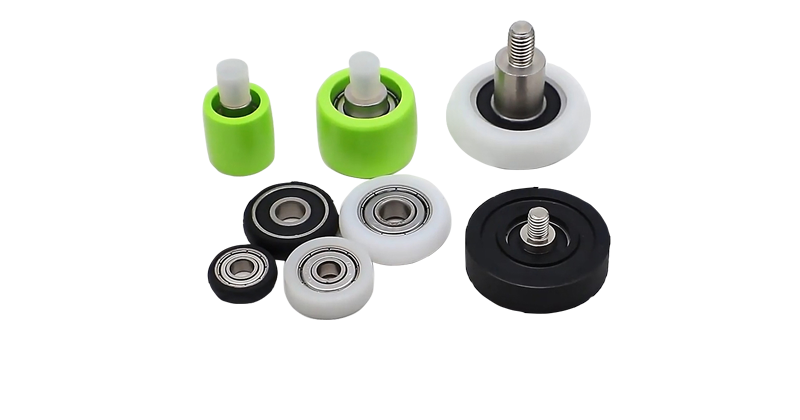86-15820855246(WhatsApp)
info@semeimachinery.com
 SEMEI Wheel Bearings : What is Plastic U Groove Pulley Wheels?
SEMEI Wheel Bearings : What is Plastic U Groove Pulley Wheels?
A Plastic U Groove Pulley Wheel is a specialized type of pulley wheel made from plastic materials and designed with a U-shaped groove along its circumference. This design is particularly useful for guiding and supporting cables, ropes, or belts in various applications.
U-Shaped Groove:
Design: The U-shaped groove is designed to securely hold and guide the cable, rope, or belt.
Benefits: Prevents the cable or rope from slipping off the pulley, ensuring smooth and reliable operation.
Material:
Common Materials: Made from various plastic materials such as polyurethane (PU), nylon (PA), acetal (POM), or polyethylene (PE).
Properties:
Polyurethane (PU): High elasticity, excellent wear resistance, and low noise.
Nylon (PA): High strength, low friction, and chemical resistance.
Acetal (POM): High stiffness, low friction, and good dimensional stability.
Polyethylene (PE): Lightweight, low friction, and chemical resistance.

Bearing:
Types: Can be equipped with ball bearings, plain bearings, or bushings.
Function: Reduces friction and ensures smooth rotation of the pulley wheel.
Materials: Bearings are often made of stainless steel or other durable materials.
Mounting Options:
Shaft Mounting: Pulleys can be mounted on a shaft using a hub or bushing.
Bolt Mounting: Some pulleys have bolt holes for direct mounting to a surface or frame.
Size and Dimensions:
Diameter: Available in various diameters to accommodate different cable or rope sizes.
Width: The width of the pulley wheel can vary to fit specific applications.
Groove Depth: The depth of the U-shaped groove is designed to match the diameter of the cable or rope.
Smooth Operation:
Reduced Friction: The U-shaped groove and bearing system reduce friction, ensuring smooth and efficient operation.
Quiet Running: Low noise levels make these pulleys suitable for applications where quiet operation is important.
Lightweight:
Weight Reduction: Plastic materials are significantly lighter than metals, reducing the overall weight of the system.
Energy Efficiency: Lighter weight can lead to reduced energy consumption in motorized systems.
Corrosion Resistance:
Non-Metallic Construction: Plastic materials are inherently resistant to corrosion, making them suitable for use in wet or corrosive environments.
Longevity: Resistance to corrosion extends the lifespan of the pulley.
Low Friction:
Self-Lubricating: Many plastic materials are self-lubricating, reducing the need for frequent maintenance.
Smooth Surface: The smooth surface of plastic pulleys helps to reduce wear on cables and ropes.
Chemical Resistance:
Compatibility: Plastic materials are resistant to many chemicals, making them suitable for use in industrial and chemical processing environments.
Durability: High chemical resistance ensures that the pulley maintains its performance over time.
Cost-Effective:
Affordable Materials: Plastic materials are generally more cost-effective than metals.
Lower Manufacturing Costs: Plastic pulleys can be manufactured through processes like injection molding, which can be more cost-effective than machining metal parts.
Consumer Goods:
Appliances: Used in washing machines, dishwashers, and other home appliances to guide belts.
Office Equipment: Used in printers, copiers, and other office machinery to guide paper and other materials.
Industrial Equipment:
Conveyor Systems: Used in conveyor belts to guide and support the belt.
Material Handling: Used in trolleys, carts, and other material handling equipment to guide cables and ropes.
Medical Devices:
Portable Equipment: Used in portable medical devices to guide cables and tubes.
Imaging Equipment: Used in MRI machines and other imaging devices to guide cables and belts.
Automotive:
Interior Components: Used in window regulators, seat mechanisms, and other interior parts to guide cables.
Exterior Components: Used in sunroof mechanisms and other exterior parts to guide cables.
Marine:
Boat Rigging: Used in sailboat rigging to guide and control ropes and lines.
Dock Equipment: Used in dock winches and pulleys for securing boats.
Installation:
Mounting: Ensure the pulley is securely mounted on the shaft or frame.
Alignment: Align the pulley with the track or guide to ensure smooth operation.
Testing: Test the pulley system to ensure it operates smoothly and safely.
Maintenance:
Regular Cleaning: Clean the pulley and track to remove dust and debris.
Lubrication: While many plastic pulleys are self-lubricating, occasional lubrication with a suitable lubricant can help maintain performance.
Inspection: Periodically inspect the pulley for signs of wear or damage and replace it if necessary.
Plastic U Groove Pulley Wheels are versatile and efficient components that offer a range of benefits, including smooth operation, lightweight construction, corrosion resistance, and low friction. They are suitable for a wide variety of applications, from consumer goods and industrial equipment to medical devices and automotive parts. By understanding their key features and proper installation and maintenance, you can ensure optimal performance and longevity.
